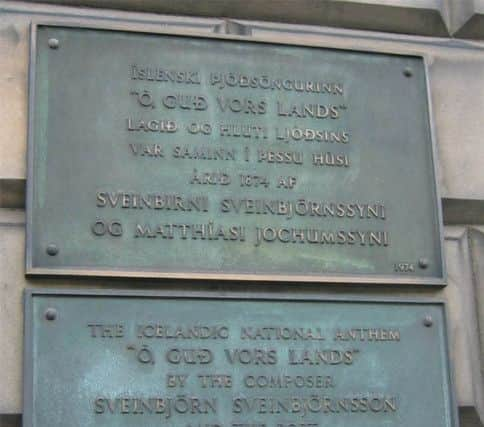Iceland's national anthem was written in an Edinburgh house


It was here that Lofsöngur, or Hymn, was written by composer Sveinbjörn Sveinbjörnsson in 1874.
The song, also known as Ó Guð vors lands (O, God of Our Land), was adopted by the island as its national anthem when it severed its political links with the Kingdom of Denmark and became a republic in 1944.
Advertisement
Hide AdAdvertisement
Hide AdWhile it may remain relatively unknown outside of Iceland, Lofsöngur has found a new international audience in recent days thanks to the Icelandic national team’s heroics at the European football championships in France.


It will be played after God Save the Queen when the Puffins - as the team are known by fans - line up against England in a second round match this evening.
The anthem’s link to Scotland is well-known among Icelandics said Kristín Hulda Hannesdóttir, head of the Icelandic Honorary Consulate in Edinburgh.
“It’s very beautiful - the music and lyrics are lovely, but it’s almost impossible to sing,” she told The Scotsman.
“You have to be a pretty good singer to reach all the high notes and the low notes. There is a noticeable shift in the middle.


“But it is a stunning song. It is used for all our important events. On Saturday, we elected our first new president in 20 years, Gudni Johannesson. He will be at the game tonight.”
The distinctive melody of Lofsöngur was composed by Sveinbjörnsson during his brief stay in Edinburgh in the early 1870s.
Advertisement
Hide AdAdvertisement
Hide AdBorn in 1847, the composer is said to have left his native land for Britain due to the then limited musical opportunities available to him.
The lyrics are the work of poet and playwright Matthías Jochumsson. Although a plaque outside 15 London Street claims they were written in Edinburgh, it is now thought Jochumsson wrote the three stanzas in Iceland.
The finished work was debuted in 1874 at a public service in Reykjavík to mark the 1000th anniversary of the island’s settlement.
It had become so popular among the Icelandic public by 1922 that the country’s parliament granted a state pension to Sveinbjörnsson, who was by then living in Copenhagen. He died five years later.
Lofsöngur remains popular, but its deeply religious sentiment has been questioned by more secular Icelandics in recent years.
One journalist wrote in an Icelandic news magazine in 2011: “Ceremonial and elaborate is all fine, but how are normal people supposed to eulogize and pay tribute to their country if nobody can sing the national anthem?”
But Lofsöngur has earned its place in Icelandic history, and ensures a small corner of Edinburgh’s New Town will be forever linked to the Atlantic island.
